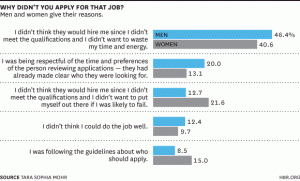With HR professionals facing so many day-to-day business distractions, it’s easy to lose sight of our loftier talent-management objectives. Human resources work is a juggling act, as anyone who works in the field knows, and it’s hard to see what lies in the distance if you’re always staring at the tasks hovering just a few inches in front of your face. When it comes to identifying, recruiting, and developing women leaders, however, it’s imperative that we work on maintaining that long-distance focus as well as get others on board to help.
Many words have been written and research conducted on the subject of women’s leadership development, including a study completed by my company in 2014. And while the findings are enlightening and the insights valuable from a standpoint of changing hearts and minds, we now have to follow through with practical steps.
As a veteran HR leader who works for an employee-assessment and talent-development company, I have the benefit of encountering HR issues both directly and through our clients relative to the services we provide to them. Thus, I’ve experienced and witnessed, on several levels, the obstacles women face when seeking leadership roles.
Obstacles women face
For example, many men either consciously or unconsciously give greater credence to what other men have to say. Women have to work extra hard to make their views and recommendations known, all the while avoiding the negative labels slapped on women who display strength (you know the words people use). In my career, I have often found myself in situations where my proposals were not heard or considered until restated by a male colleague. The challenge is making one’s presence known in an assertive and professional manner, and successfully doing so often involves first developing one’s presence in a tactical and determined way.
 Research shows that many women will apply for advancement only if they exceed the qualifications listed, whereas men often apply (and are hired) regardless of whether they meet the on-paper requirements. We women need to embolden ourselves to take those same chances!
Research shows that many women will apply for advancement only if they exceed the qualifications listed, whereas men often apply (and are hired) regardless of whether they meet the on-paper requirements. We women need to embolden ourselves to take those same chances!
More women than men graduate college nowadays, and that trend is only increasing. By logical extension, the potential pool of future leaders will include a higher percentage of women than ever before. Thus, for companies to find and attract the best candidates, they’ll need to focus on identifying and developing those high-potential employees instead of falling into the “old habits” trap and assuming only men can or want to lead.
Women bring strengths men may lack
Organizations will benefit greatly from adding more women to the leadership matrix. The women leaders study conducted by my firm corroborates the results of similar studies: Women tend to be more focused on staff development and are typically more inclusive, two factors that can increase employee satisfaction, engagement, and retention. Also, women leaders increase the diversity of ideas.
Experience diversity speaks to the value of fresh ideas offered by those who come from different industries or backgrounds, a philosophy that has come to be viewed in recent years as superior to the old-school “team of experts” approach to planning and decision making. Adding women to the strategic side of business development can help foster new and innovative perspectives that would not have arisen otherwise.
For the time being, however, you can expect opposition from those who feel threatened by an increased presence of women in leadership roles and who see it as a zero-sum proposition. It’s important for women to help change that mindset by showing how women leaders can help companies become more healthy and profitable (which benefits everyone). Don’t be afraid to recruit allies in rolling out this message, and, for your own development and growth in leadership, find a mentor.
I believe in putting my money where my mouth is, so to speak, so I’m not simply talking about women leaders. Together with other women leaders at my company, I’ve helped put together a women’s leadership development workshop that is offered periodically throughout the year. We promote the workshop externally to our clients and to any budding women leaders who wish to attend, but there’s nothing to stop you from designing and implementing your own women leaders program within your organization. Put those collaboration and inclusivity skills to work!
